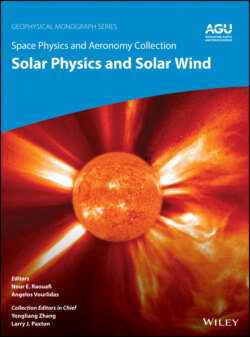Читать книгу Space Physics and Aeronomy, Solar Physics and Solar Wind - Группа авторов - Страница 21
1.4. WAVES AND TURBULENCE 1.4.1. Spectra of Solar Wind Fluctuations at All Scales
ОглавлениеIn situ measurements allow us to make detailed analysis of electromagnetic fluctuations in the solar wind plasma over a wide range of scales. Figure 1.14 (left) shows an example of a composite magnetic spectrum taken at 1 AU using the ACE and Cluster spacecraft (Kiyani et al., 2015). Fluctuations are organized in different frequency ranges, each with a different power law. The main central part (10−3Hz < f < 10−1Hz) is characterized by a Kolmogorov −5/3 spectral slope; this corresponds to the inertial range of an MHD turbulent cascade that transports energy from large to small scales, as in hydrodynamics turbulence (Bruno & Carbone, 2013).
It should be recalled here that due to the high speed of the solar wind flow compared to the typical velocities associated to the motion of the plasma fluctuations (Taylor hypothesis), time frequencies measured in the spacecraft frame can be interpreted as spatial k‐vectors in the plasma frame. It is then possible to study the 3D distribution of k‐vectors in the inertial range using measurements at different angles with respect to the main field (Horbury et al., 2008; Saur & Bieber, 1999; Wicks et al., 2010); this suggests a quasi‐2D distribution of the power, constituted by very elongated turbulent eddies along the magnetic field and a turbulent cascade that occurs preferentially for k‐vectors perpendicular with respect to the magnetic field.
At larger scales, the spectrum of magnetic fluctuations is often characterized by a shallower slope, close to −1 (Bavassano, Dobrowolny, Mariani et al., 1982; Denskat & Neubauer, 1982); this range, called 1/f, is sometimes considered as the energy reservoir for the turbulent cascade, in analogy with hydrodynamics, although this analogy is not necessarily straightforward (Tu & Marsch, 1995) and more generally, the origin of the 1/f range is still under debate in the community (Chandran, 2018; Matteini et al., 2018; Matthaeus & Goldstein, 1986; Velli et al., 1989; Verdini et al., 2012).
At higher frequencies, around scales corresponding to the typical ion characteristic lengths (ion gyroradius ρi and inertial length di ), the spectrum becomes steeper. This is expected when MHD breaks down, and kinetic physics starts to play a role. Moreover, fluctuations become more compressible at these scales, as a result of the transition from a regime where the electric field is controlled by ideal‐MHD to a Hall‐MHD regime (e.g., Alexandrova et al., 2008; Kiyani et al., 2013; Lacombe et al., 2017). As a consequence, the spectrum of the electric field, which follows that of the magnetic field at large MHD fluid scales, starts to depart at ion scales and display a shallower spectral slope at sub‐ion scale, such that the ratio of electric‐to‐magnetic fluctuations increases linearly with f (Matteini et al., 2017).
At even higher frequencies, approaching electron plasma scales (f: 50–100Hz, corresponding to a few km at 1 AU), the magnetic spectrum of the background turbulence steepens further; see Figure 1.14 (right). We will discuss the background turbulence at electron scales in more detail below. Note that at these frequencies whistler wave activity is also sometimes observed, characterized by right‐handed circular polarization very distinct from that of the background turbulence (Kajdič et al., 2016a; Lacombe et al., 2014; O. W. Roberts et al., 2017; Stansby et al., 2016)
Figure 1.14 Top: Typical spectrum of magnetic field fluctuations in the solar wind from Kiyani et al. (2015). Measurements of ACE and Cluster at 1 AU from MHD to electron scales are shown. Doppler‐shifted characteristic scales, such as the correlation length λc and the ion and electron Larmor radii ρi, e are indicated by vertical dashed lines. Bottom: Superposed (more then 100) turbulent spectra of magnetic fluctuations under different plasma conditions from inertial to sub‐electron scales as measured by Cluster (Alexandrova et al., 2012).
(Source: Kiyani et al., 2015.)
